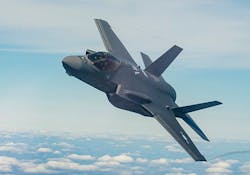USAF and US Army integrate fighters and missle defense
WHITE SANDS MISSILE RANGE, N.M. – Two U.S. Air Force F-35s were integrated with the U.S. Army Integrated Air and Missile Defense Battle Command System (IBCS), providing an airborne sensor capability to successfully detect, track and intercept near simultaneous air-breathing threats in a test at White Sands Missile Range, New Mexico. The test marked the first time F-35s were used as sensors during an IBCS live fire test against multiple airborne targets.
Linking F-35s to IBCS via the Multifunction Advanced Data Link (MADL) provided enhanced situational awareness and weapons-quality track data to engage airborne targets. The proof of concept demonstration used experimental equipment developed by Lockheed Martin, including the Harvest Lightning Ground Station and IBCS adaptation kit (A-Kit).
This test is the latest in a series to demonstrate the F-35’s role as the keystone of the joint force. Lockheed Martin is evolving technologies that connect, share and learn to create a holistic network that provides unprecedented situational awareness across the battlespace and enables Multi-Domain Operations.
